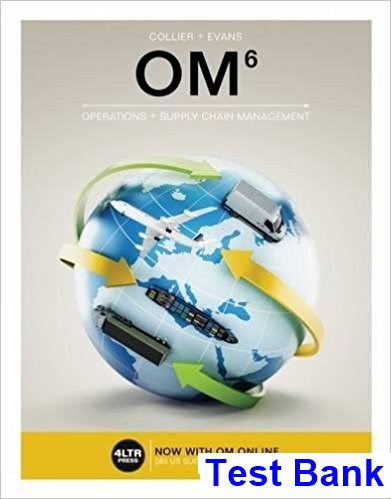OM 6th Edition Collier Test Bank

Product details:
- ISBN-10 : 1305664396
- ISBN-13 : 978-1305664395
- Author: David A. Collier
Learn YOUR Way with OM! OM�s easy-reference, textbook presents course content through visually engaging chapters as well as Chapter Review Cards that consolidate the best review material into a ready-made study tool. With the textbook or on its own, OM MindTap allows you to learn on your terms. Read or listen to textbooks and study with the aid of instructor notifications, flashcards and practice quizzes. Track your scores and stay motivated toward your goals. Whether you have more work to do or are ahead of the curve, you�ll know where you need to focus your efforts. And the MindTap Green Dot will charge your confidence along the way. When it�s time to study, everything you�ve flagged or noted can be gathered into a guide you can organize.
Table contents:
- Part 1: Basic Concepts of OM and Value Chains
- Chapter 1: Operations Management And Value Chains
- 1-1 Operations Management
- 1-2 OM in The Workplace
- 1-3 Understanding Goods And Services
- 1-4 The Concept Of Value
- 1-5 Customer Benefit Packages
- 1-6 Value Chains
- 1-6a Processes
- 1-7 Value Chain Frameworks
- 1-7a Value Chains: An Input-Output Framework
- 1-7b The Value Chain At Buhrke Industries Inc.
- 1-7c Value Chains: Preand Postproduction Services Framework
- 1-7d The Value Chain At Amazon
- 1-7e Value Chains: Hierarchical Supply Chain Framework
- 1-8 Om: A History Of Change And Challenge
- 1-8a A Focus On Efficiency
- 1-8b The Quality Revolution
- 1-8c Customization And Design
- 1-8d Time-Based Competition
- 1-8e The Service Revolution
- 1-8f Sustainability
- 1-8g Data And Analytics
- 1-9 KEY Challenges
- Chapter 2: Measuring Performance In Operations And Value Chains
- 2-1 Types Of Performance Measures
- 2-1a Financial Measures
- 2-1b Customer And Market Measures
- 2-1c Quality
- 2-1d Time
- 2-1e Flexibility
- 2-1f Innovation And Learning
- 2-1g Productivity And Operational Efficiency
- 2-1h Sustainability
- 2-2 Analytics In Operations Management
- 2-2a Linking Internal And External Measures
- 2-2b The Value Of A Loyal Customer
- 2-3 Designing Measurement Systems In Operations
- 2-4 Models Of Organizational Performance
- 2-4a Malcolm Baldrige Performance Excellence Framework
- 2-4b The Balanced Scorecard
- 2-4c The Value Chain Model
- 2-4d The Service-Profit Chain
- Chapter 3: Operations Strategy
- 3-1 Gaining Competitive Advantage
- 3-2 Understanding Customer Wants And Needs
- 3-3 Evaluating Goods And Services
- 3-4 Competitive Priorities
- 3-4a Cost
- 3-4b Quality
- 3-4c Time
- 3-4d Flexibility
- 3-4e Innovation
- 3-5 OM and Strategic Planning
- 3-5a Operations Strategy
- 3-5b Sustainability And Operations Strategy
- 3-6 A Framework For Operations Strategy
- 3-6a Operations Strategy at McDonald’s
- Chapter 4: Technology And Operations Management
- 4-1 Understanding Technology In Operations
- 4-1a Manufacturing Technology
- 4-1b Computer-Integrated Manufacturing Systems (CIMSs)
- 4-1c Advances In Manufacturing Technology
- 4-1d Service Technology
- 4-2 Technology In Value Chains
- 4-3 Benefits And Challenges Of Technology
- 4-4 Technology Decisions And Implementation
- Part 2: Designing Operations and Supply Chains
- Chapter 5: Goods And Service Design
- 5-1 Designing Goods And Services
- 5-2 Customer-Focused Design
- 5-3a Tolerance Design And The Taguchi Loss Function
- 5-3 Designing Manufactured Goods
- 5-3b Design For Reliability
- 5-3c Design For Manufacturability
- 5-3d Design For Sustainability
- 5-4 Service-Delivery System Design
- 5-4a Facility Location And Layout
- 5-4b Servicescape
- 5-4c Service Process And Job Design
- 5-4d Technology And Information Support Systems
- 5-5 Service-Encounter Design
- 5-5a Customer-Contact Behavior And Skills
- 5-5b Service-Provider Selection, Development, and Empowerment
- 5-5c Recognition And Reward
- 5-5d Service Guarantees And Recovery
- 5-6 An Integrative Case Study Of LensCrafters
- Chapter 6: Supply Chain Design
- 6-1 Global Supply Chains
- 6-1a Decisions In Supply Chain Design
- 6-2 Supply Chain Design Trade-Offs
- 6-2a Efficient And Responsive Supply Chains
- 6-2b Push And Pull Systems
- 6-2c Vertical Integration, Outsourcing, And Offshoring Decisions
- 6-2d The Economics Of Outsourcing Decisions
- 6-2e Offshoring And Reshoring
- 6-3 A Global Supply Chain Example: Inditex/Zara
- 6-4 Location Decisions
- 6-4a Critical Factors In Location Decisions
- 6-3b Location Decision Process
- 6-4c The Center-of-Gravity Method
- 6-5 Supply Chain Optimization
- Chapter 7: Process Selection, Design, And Analysis
- 7-1 Process Choice Decisions
- 7-2 The Product-Process Matrix
- 7-3 The Service-Positioning Matrix
- 7-4 Process Design
- 7-4a Process And Value Stream Mapping
- 7-5 Process Analysis And Improvement
- 7-6 Process Design And Resource Utilization
- 7-6a Little’s Law
- Chapter 8: Facility And Work Design
- 8-1 Facility Layout
- 8-1a Product Layout
- 8-1b Process Layout
- 8-1c Cellular Layout
- 8-1d Fixed-position Layout
- 8-1e Facility Layout In Service Organizations
- 8-2 Designing Product Layouts
- 8-2a Assembly-Line Balancing
- 8-2b Line-Balancing Approaches
- 8-3 Designing Process Layouts
- 8-4 Workplace And Job Design
- 8-4a Workplace Design
- 8-4b Job Design
- 8-4c Safety, Ergonomics, And The Work Environment
- 8-4d Workforce Ethics And Global Supply Chains
- Part 3: Managing Operations and Supply Chains
- Chapter 9: Forecasting And Demand Planning
- 9-1 Forecasting And Demand Planning
- 9-2 Basic Concepts In Forecasting
- 9-2a Forecast Planning Horizon
- 9-2b Data Patterns In Time Series
- 9-2c Forecast Errors And Accuracy
- 9-3 Statistical Forecasting Models
- 9-3a Simple Moving Average
- 9-3b Single Exponential Smoothing
- 9-4 Regression As A Forecasting Approach
- 9-4a Excel’s Add Trendline Option
- 9-4b Causal Forecasting Models With Multiple Regression
- 9-5 Judgmental Forecasting
- 9-6 Forecasting In Practice
- Chapter 10: Capacity Management
- 10-1 Understanding Capacity
- 10-1a Economies And Diseconomies Of Scale
- 10-2 Capacity Measurement In Operations
- 10-2a Safety Capacity
- 10-2b Capacity Measurement
- 10-2c Using Capacity Measures For Operations Planning
- 10-3 Long-Term Capacity Strategies
- 10-3a Capacity Expansion
- 10-4 Short-Term Capacity Management
- 10-4a Managing Capacity By Adjusting Short-term Capacity Levels
- 10-4b Managing Capacity By Shifting And Stimulating Demand
- 10-4c Revenue Management Systems (RMS)
- 10-5 Theory Of Constraints
- Chapter 11: Managing Inventories In Supply Chains
- 11-1 Understanding Inventory
- 11-1a Key Definitions And Concepts
- 11-1b Managing Inventories In Global Supply Chains
- 11-1c Inventory Management Decisions And Costs
- 11-2 Inventory Characteristics
- 11-3 ABC Inventory Analysis
- 11-4 Managing Fixed-quantity Inventory Systems
- 11-4a The EOQ Model
- 11-4b Safety Stock And Uncertain Demand In A Fixed-Order-Quantity System
- 11-5 Managing Fixed-period Inventory Systems
- 11-6 Single-Period Inventory Model
- Chapter 12: Supply Chain Management And Logistics
- 12-1 Managing Supply Chains
- 12-1a The SCOR Model
- 12-1b Sourcing And Purchasing
- 12-1c Managing Supplier Relationships
- 12-1d Supply And Value Chain Integration
- 12-2 Logistics
- 12-2a Transportation
- 12-2b Inventory Management
- 12-3 Risk Management In Supply Chains
- 12-4 S Upply Chains In E-Commerce
- 12-5 Measuring Supply Chain Performance
- 12-5a Total Supply Chain Costs
- 12-5b The Cash-to-Cash Conversion Cycle
- 12-5c Supplier Evaluation And Certification
- 12-6 Sustainability In Supply Chains
- 12-6a Green Sustainable Supply Chains
- 12-6b Manufactured Goods Recovery And Reverse Logistics
- Chapter 13: Resource Management
- 13-1 Resource Planning Framework For Goods And Services
- 13-1a Resource Planning In Service Organizations
- 13-1b Enterprise Resource Planning
- 13-2 Aggregate Planning Options
- 13-3 Strategies For Aggregate Planning
- 13-4 Disaggregation In Manufacturing
- 13-4a Master Production Scheduling
- 13-4b Materials Requirements Planning
- 13-4c Time Phasing And Lot Sizing In Mrp
- 13-5 Capacity Requirements Planning
- Chapter 14: Operations Scheduling And Sequencing
- 14-1 Understanding Scheduling And Sequencing
- 14-2 Scheduling Applications And Approaches
- 14-2a Staff Scheduling
- 14-2b Appointment Systems
- 14-3 Sequencing
- 14-3a Sequencing Performance Criteria
- 14-3b Sequencing Rules
- 14-4 Applications Of Sequencing Rules
- 14-4a Single-Resource Sequencing Problem
- 14-4b Two-Resource Sequencing Problem
- 14-5 Schedule Monitoring And Control
- 14-6 Vehicle Routing And Scheduling
- Chapter 15: Quality Management
- 15-1 Understanding Quality
- 15-2 Influential Leaders In Modern Quality Management
- 15-2a W. Edwards Deming
- 15-2b Joseph Juran
- 15-2c Philip B. Crosby
- 15-3 The Gap Model
- 15-4 ISO 9000:2000
- 15-5 Six Sigma
- 15-5a Implementing Six Sigma
- 15-6 Cost-of-quality Measurement
- 15-7 The “Seven QC Tools”
- 15-7a Root Cause Analysis
- 15-8 Other Quality Improvement Strategies
- 15-8a Kaizen
- 15-8b Poka-Yoke (Mistake-Proofing)
- Chapter 16: Quality Control And SPC
- 16-1 Quality Control Systems
- 16-1a Quality Control Practices In Manufacturing
- 16-1b Quality Control Practices In Services
- 16-2 Statistical Process Control And Variation
- 16-3 Constructing Control Charts
- 16-3a Constructing x- and R-Charts
- 16-3b Interpreting Patterns In Control Charts
- 16-3c Constructing p-Charts
- 16-3d Constructing c-Charts
- 16-4 Practical Issues In SPC Implementation
- 16-4a Controlling Six Sigma Processes
- 16-5 Process Capability
- 16-5a Process Capability Index
- Chapter 17: Lean Operating Systems
- 17-1 Principles Of Lean Operating Systems
- 17-2 Lean Tools And Approaches
- 17-2a The 5Ss
- 17-2b Visual Controls
- 17-2c Single Minute Exchange Of Dies (SMED)
- 17-2d Small Batch And Single-Piece Flow
- 17-2e Quality And Continuous Improvement
- 17-2f Total Productive Maintenance
- 17-3 Lean Six Sigma
- 17-4 Lean Manufacturing And Service Tours
- 17-4a Timken Company
- 17-4b Southwest Airlines
- 17-5 Just-in-Time Systems
- 17-5a Operation of A JIT System
- 17-5b JIT in Service Organizations
- Chapter 18: Project Management
- 18-1 The Scope Of Project Management
- 18-1a Roles Of The Project Manager And Team Members
- 18-1b Organizational Structure
- 18-1c Factors For Successful Projects
- 18-2 Techniques For Planning, Scheduling, And Controlling Projects
- 18-2a Project Definition
- 18-2b Resource Planning
- 18-2c Project Scheduling With The Critical Path Method
- 18-2d Project Control
- 18-3 Time/Cost Trade-Offs
- 18-4 Uncertainty In Project Management
- Appendix A: Areas For the Cumulative Standard Normal Distribution
- Appendix B: Factors For Control Charts
- Appendix C: Random Digits
- Endnotes
- Index
- Tear-out cards
People also search:
om 6th edition pdf
om 6th edition pdf free download
6th edition of ama guidelines
6th edition of the ama guides





